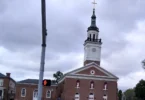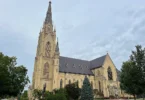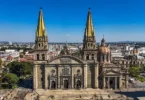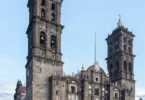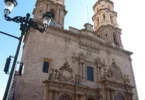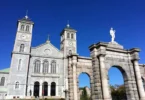Introduction
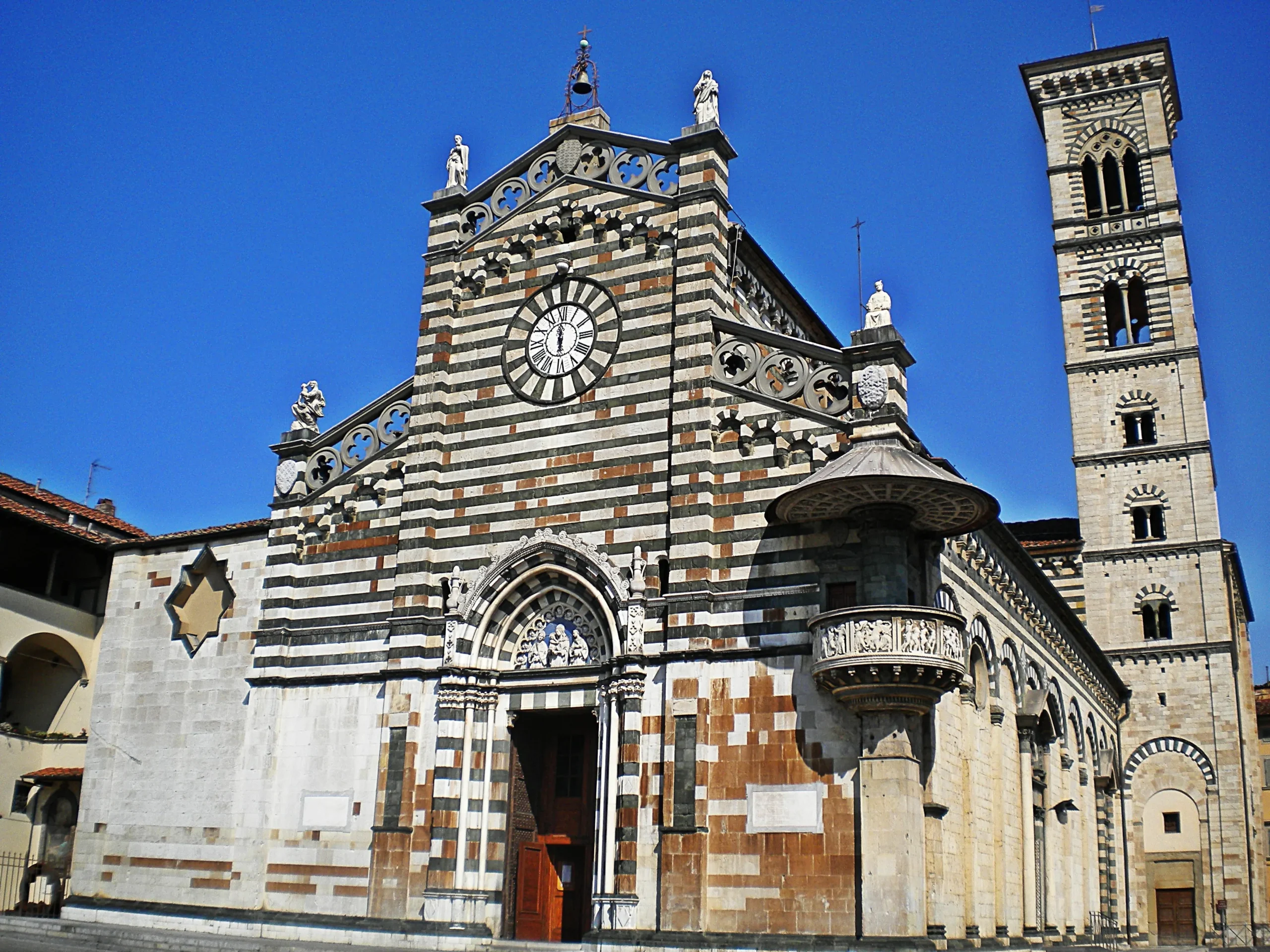
Prato Cathedral, officially known as the Cathedral of Saint Stephen (Italian: Duomo di Prato; Cattedrale di San Stefano), is a distinguished Roman Catholic cathedral located in the heart of Prato, a city in the Tuscany region of central Italy. This iconic edifice serves as the seat of the Bishop of Prato, a position it has held since 1954. Prior to this, from 1653, it had been the cathedral of the Diocese of Pistoia and Prato. The cathedral is dedicated to Saint Stephen, the first Christian martyr, reflecting the deep religious heritage of the region. Dating back to the 10th century, the cathedral is one of the oldest and most significant churches in Prato. Its construction unfolded over several phases, with the building initially constructed in the Romanesque architectural style. This long history is evident in the cathedral’s structure, which combines a range of architectural influences as it evolved over the centuries. Not only a place of worship, the cathedral is a celebrated repository of art and culture, housing a remarkable collection of works, particularly in the realm of sculpture.
Among the cathedral’s most notable artistic treasures are the exquisite frescoes by the renowned artist Filippo Lippi, which adorn the interior and are regarded as some of the most important fresco cycles in Italian art. On the exterior, the cathedral boasts a striking pulpit, created by the eminent architect Michelozzo and decorated by the famed sculptor Donatello, further showcasing its artistic and architectural significance. In recognition of its historical and cultural importance, Pope John Paul II elevated Prato Cathedral to the status of a minor basilica in July 1996, underscoring its prominence within the Catholic Church. Today, the cathedral stands not only as a central place of worship but also as a celebrated Italian national monument, attracting visitors from around the world who come to admire its rich history, stunning art, and architectural splendor..
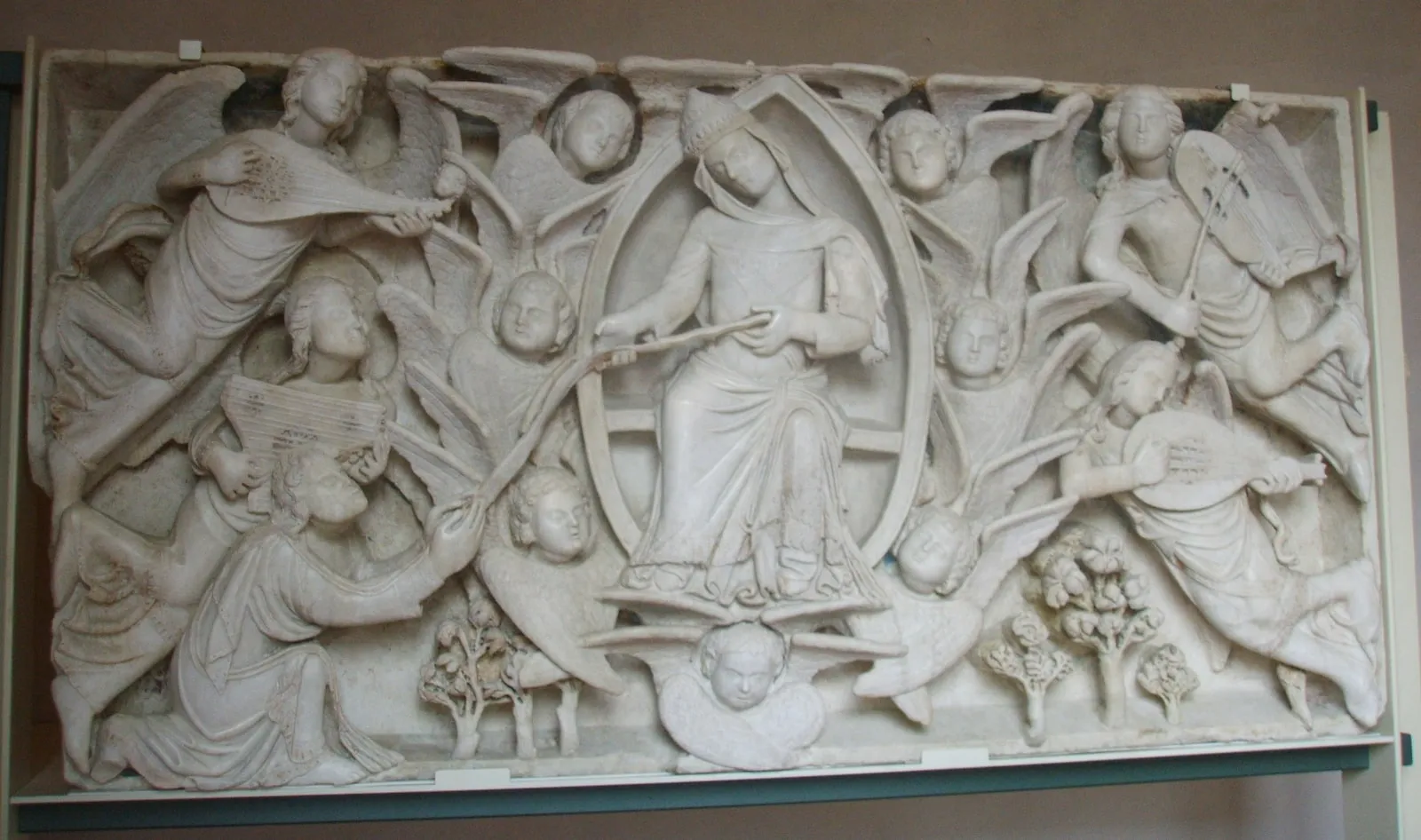
Early Origins and Construction (6th-10th Century)
Prato Cathedral, officially known as the Cathedral of Saint Stephen (Cattedrale di San Stefano), has its roots deep in the history of Prato. It is one of the oldest churches in the city, with documentation of its existence dating back to at least the 10th century. However, it is believed to have been in place since at least the 6th century, as the parish church of Santo Stefano. Located in the meadow (prato) after which the city is named, the cathedral was originally the main church of Borgo al Cornio, the first settlement of Prato. The first structure was a small parish church, and it was known as the Pieve di Santo Stefano by AD 994. Over the centuries, the church underwent numerous renovations and expansions. From the 10th to the 15th century, it saw several stages of transformation, yet it maintains a unified appearance due to the harmonious design of its architectural volumes and the distinct two-tone exterior, which features alberese stone and the characteristic green Prato marble (serpentine).
12th to 15th Century Expansion and Reconstruction
The church as it stands today primarily stems from a significant period of reconstruction that began in the 12th century. The Romanesque cloister and the sides of the church are remnants of this era. The bell tower, designed by the architect Guidetto da Como, was constructed beginning in the early 13th century, with the final cell at the top completed in 1356. In the 14th century, the cathedral underwent major expansions, driven in part by the increasing significance of the relic of the Holy Belt (Sacra Cintola) which had been brought to Prato in 1141, according to tradition. This sacred relic became a major draw for pilgrims, prompting the enlargement of the cathedral. The first half of the century saw the addition of the transept, likely designed by Giovanni Pisano or one of his pupils. The second half of the century brought about the construction of the Chapel of the Belt and the beginning of the new façade. The façade was not completed until 1456, and the area in front of the building was cleared to create a large square, intended to accommodate the growing crowds who gathered for religious displays and processions involving the Holy Belt.
The 15th Century and the Arrival of Key Artistic Works
By the early 15th century, the cathedral had taken on a more Gothic appearance with the construction of a new façade in the International Gothic style. This façade was built over the old one and was accompanied by a new narthex or corridor that led to the external pulpit. The pulpit itself was created by Michelozzo, a renowned architect, and was decorated by Donatello between 1428 and 1438. The original seven reliefs of the pulpit parapet were removed in 1967 and are now housed in Prato’s cathedral museum.
Architecture of Cathedral Basilica of St. Stephen, Prato, Italy
Architectural style: Romanesque architecture.
Overall Exterior Design
The exterior of the Cathedral of Prato, despite having undergone numerous restorations and additions over the centuries, presents a visually cohesive and harmonious architectural style. A hallmark of the structure is its distinctive polychrome decoration, created through the alternating use of alberese (white limestone) and green marble from Prato. This white-and-green striped effect is a defining characteristic of both the cathedral’s exterior and interior.
Façade
13th-Century Façade
The first known façade, constructed in the 13th century, was designed by Guidetto da Como. Though it is largely hidden today, parts of this original structure are still visible through a cavity beneath the current façade. The earlier façade featured a plain lower section made of alberese stone and a striped upper portion. Its exact form is difficult to reconstruct, but it likely included a single central portal, a mullioned window, and two smaller arched openings. Small hanging arches may have topped the façade, supported by corner pilasters, and leonine protomes (lion-head sculptures) marked the junctions of the sloped rooflines.
Late Gothic Façade (1386–1457)
The current façade, built between 1386 and 1457, was designed by Niccolò di Piero Lamberti (nicknamed “Pela”). It exemplifies late Gothic style and was constructed using Pietra alberese and green marble, continuing the church’s signature two-tone theme. The design includes a single grand portal and a central clock instead of a traditional rose window. The façade was built slightly in front of the original, creating a narrow corridor between them that leads to the external pulpit. Above the main entrance is a lunette containing a glazed terracotta relief by Andrea della Robbia. This artwork features the Madonna flanked by Saints Stephen and Lawrence.
The Clock
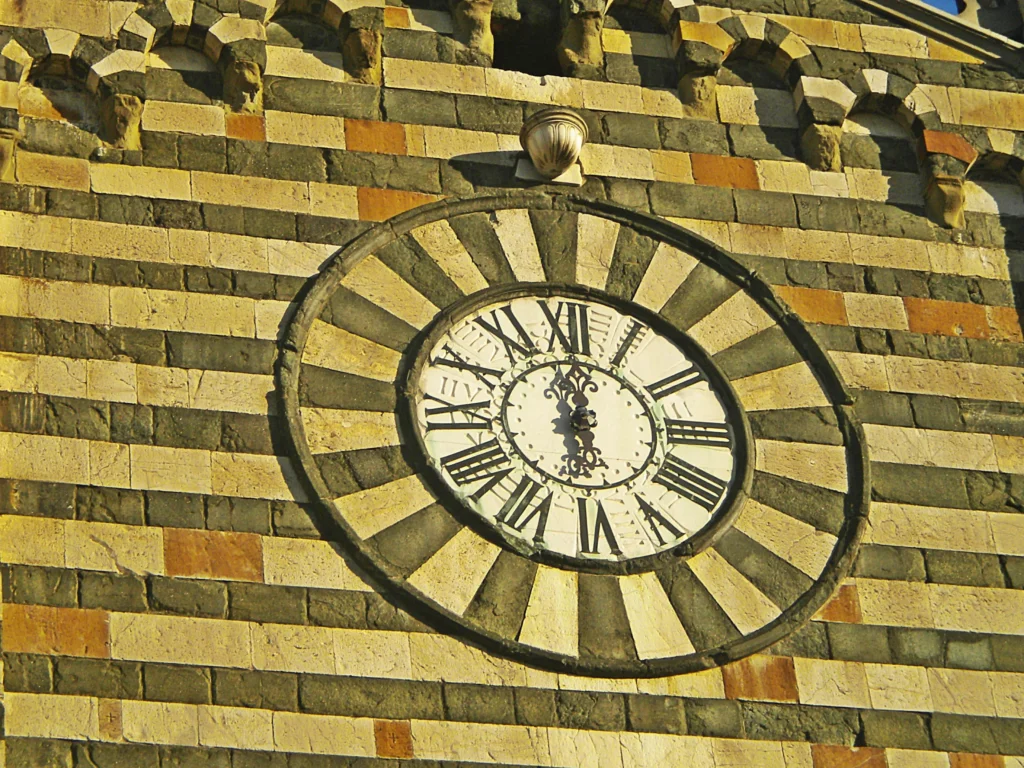
Installed in the mid-15th century, the façade clock originally featured a mechanical child figure that rang the hours. A written record from 1480 notes a repair to this figure. The clock was replaced in 1795 by a new mechanism crafted by Domenico Magheri, a local clockmaker. A Latin inscription beneath it reads: “AMDP Dominicus Magheri Pratensis fecit Anno Domini 1795 – volat ambiguis volubilis alis hora”, which translates loosely to, “Dominicus Magheri of Prato made this in the Year of Our Lord 1795 – time flies with unpredictable, ever-turning wings.” The original clock mechanism is now preserved inside the cathedral behind plexiglass. The façade still features the 24 Roman numerals of the original clock dial, overlaid today with 12 raised bronze numerals. Inside, a secondary clock face with six Roman numerals is found on the counter-façade. A bell that once rang with the clock was cast in 1795 by Iacopo Cari of Pistoia and is still positioned atop the façade.
Right Flank
Renovated around 1160, the cathedral’s right side contains two intricately decorated portals, embellished with symbolic motifs that have not yet been deciphered. This side also features the bell tower, attributed to Guidetto da Como, originally conceived as part of the church’s symmetrical design. The structure is adorned with double lancet windows that widen significantly in the penultimate level, culminating in a spacious Gothic bell chamber with large triple-lancet openings, added in the 14th century. A compact block of alberese stone—part of the transept—rests on the bell tower. The final, flat-roofed bell cell is said to have inspired the bell tower design later developed by Giotto for Florence Cathedral. A modest sundial is also located on this side of the building. It consists of a gnomon and a meridian line, marking the apparent solar noon during solstices. Next to the bell tower is a portal with a reddish stain in the lunette above it. According to local legend, the stain is the blood of a man named Musciattino from Pistoia, who tried to steal the Sacred Girdle in the Middle Ages. Caught and punished by amputation, one of his severed hands reportedly flew through the air and struck the cathedral wall, leaving the mysterious red mark still visible today.
The Bell Tower
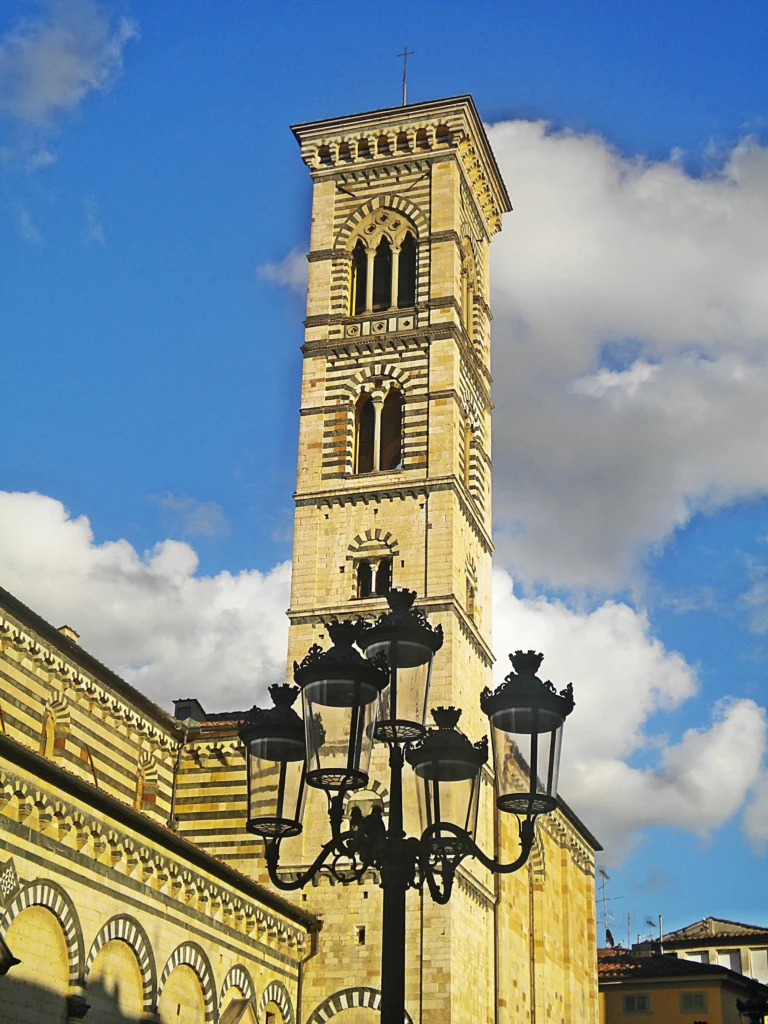
Rising to a height of 46 meters, the bell tower of Prato Cathedral stands as the tallest structure in the city and a prominent feature of its skyline. Its earliest section dates back to around 1160, forming an integral part of the church’s southern façade. In 1211, a contract was formalized with Guidetto da Como, a master marble worker from Lucca, who was entrusted with completing the tower. The agreement granted him permission to return to Lucca periodically, likely to supervise his other ongoing projects. By approximately 1220, Guidetto had completed the upper section, constructing four distinct levels. In the 14th century, the addition of the cathedral’s transept required the tower to be raised further, and this final level was completed in 1356. Remarkably, the structure has remained unchanged since then. The interior features a 177-step staircase leading to a viewing platform, which was reopened to the public in 2019 following a significant restoration campaign that began in 2010.
Housed within the bell tower is an exceptional set of five large bells, considered the heaviest in the Diocese of Prato and among the most important in Tuscany. Tuned to the B2 minor scale, these bells date primarily to the 18th century and were cast by members of the famed Moreni family of Florence. The largest, known as “Grossa” or “Dondolona,” was originally cast in 1601 by Jacopo da Seravezza and later restored by Giovanni Domenico Moreni in 1756; it weighs 2,400 kg and is used to ring the Angelus. The “Campana delle Undici,” cast in 1766 by Alessandro Tognozzi Moreni, weighs 1,800 kg and rings daily at 11:00 am. The “Santa Caterina Ricci,” first cast in 1597 and recast in 1755, weighs 1,300 kg. The “Seconda,” cast in 1737, weighs 850 kg, and the smaller bell from 1549—recast in 1775—comes in at 650 kg. Additionally, a rare smaller bell named “Stefanina,” created in 1316 by Gregorio da Reggio and weighing 110 kg, is preserved but seldom rung due to its age and historical value. A beloved Pratese tradition associated with the bell tower is the Grande Doppio, a grand ceremonial ringing performed on the eve of major liturgical feasts. This resonant ritual lasts around nine minutes, beginning with each bell tolling individually before culminating in a dramatic Plenum—the simultaneous ringing of all bells in majestic unison.
Donatello’s External Pulpit
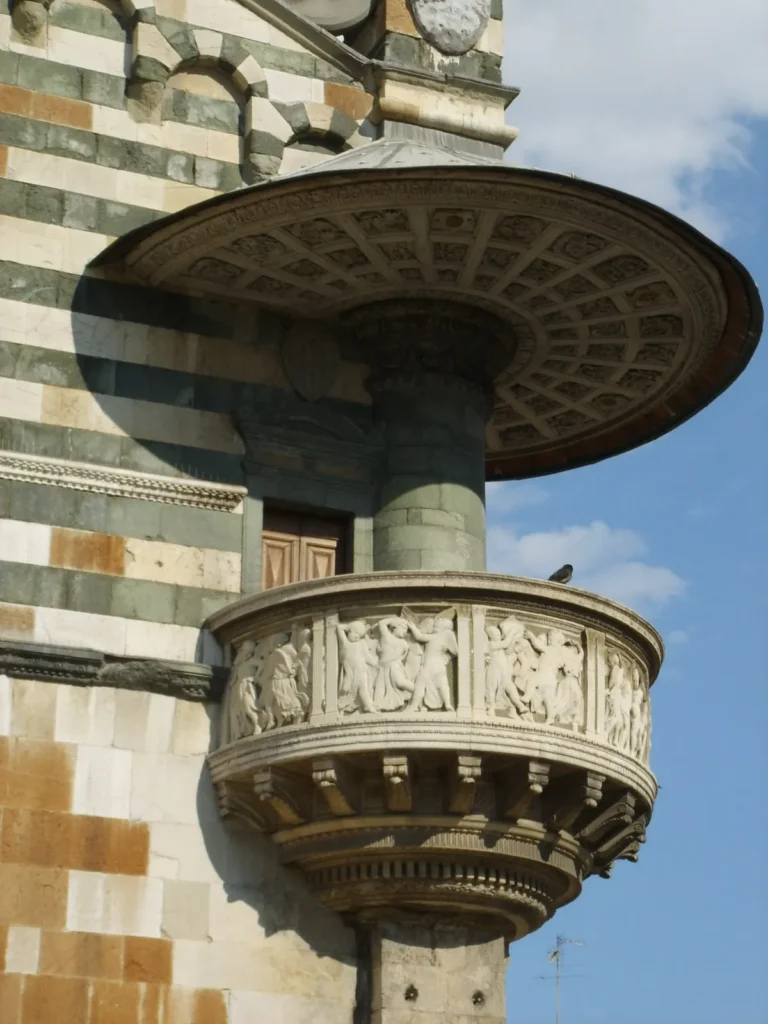
Between 1428 and 1438, an external pulpit was constructed to display the Sacred Girdle (Cintola della Madonna) to the public. It was built by the architect Michelozzo and adorned with reliefs by Donatello. The pulpit is mounted on a gilded bronze capital and features concentric marble moldings that accentuate its dynamic, outward-radiating design. The parapet—now preserved in the nearby Cathedral Museum—resembles a miniature temple populated with lively groups of putti (cherubic children) engaged in joyful dances, including the traditional farandòla. A graceful, umbrella-like canopy tops the structure. The relic of the Sacred Girdle is displayed from this pulpit five times a year: on Christmas, Easter, May 1st, August 15th, and most solemnly on September 8th, the Feast of the Nativity of the Virgin Mary.
Internal
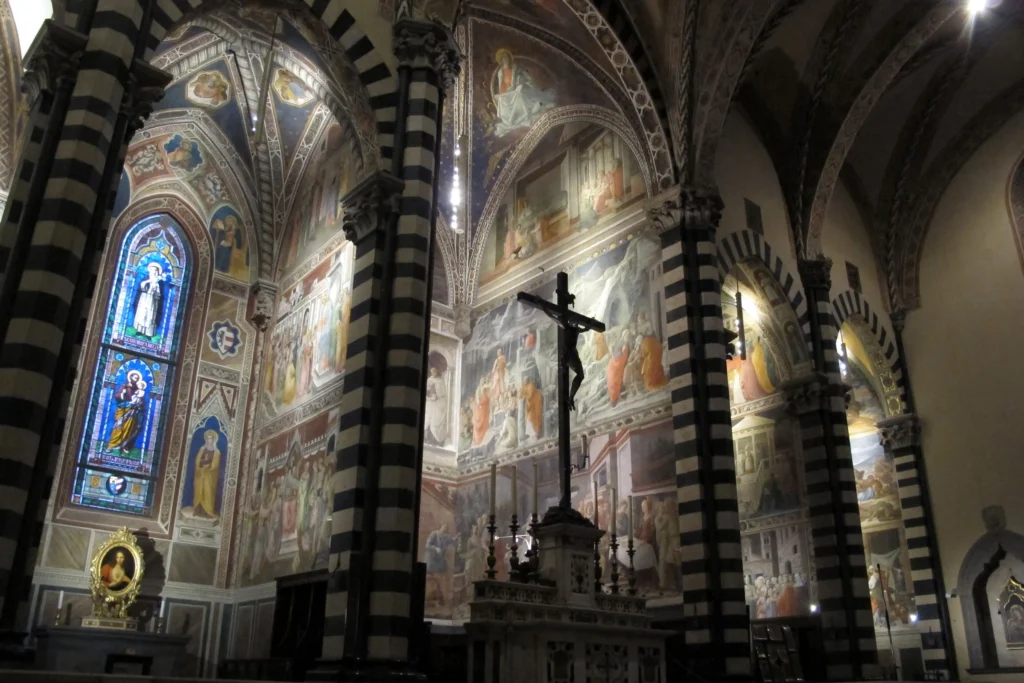
Naves
Upon entering the Cathedral of Santo Stefano, the interior unfolds in a Latin cross layout. Despite numerous renovations over the centuries, it maintains a cohesive and harmonious architectural appearance. The three Romanesque naves, dating from the early 13th century, are separated by grand arches resting on fine columns crafted from green serpentine marble. These columns feature intricately carved capitals, attributed to the master sculptor Guidetto da Como. Above the arches, the walls display alternating bands of alberese and green marble, a stylistic motif characteristic of Tuscan Romanesque architecture. The central nave is covered by a barrel vault with lunettes, constructed in the 17th century following the design of Ferdinando Tacca. The baroque window frames throughout the nave are from the same period, adding a decorative flourish to the architectural ensemble.
A highlight of the left nave, under the penultimate arch, is the Renaissance marble pulpit (1469–1473). Elegant and chalice-shaped, it stands on a base adorned with sphinxes, created by Maso di Bartolomeo and Pasquino da Montepulciano. The pulpit’s parapet features finely detailed reliefs of remarkable narrative expressiveness by Antonio Rossellino and Mino da Fiesole, depicting the Assumption, Scenes from the Life of St. Stephen, and Scenes from the Life of St. John the Baptist. Facing the pulpit in the opposite nave is a bronze candelabrum (1440) by Maso di Bartolomeo. Shaped like a slender vase, it sprouts seven robust plant-like stems. The original model is now preserved at the Museum of Fine Arts in Boston. Nearby, Maso also constructed the internal terrace on the counter-façade, featuring an Assumption of the Virgin painted by David and Ridolfo del Ghirlandaio. At the front of the Chapel of the Sacred Belt, there is a poignant wooden Crucifix, likely the most renowned work of Giovanni Pisano, known for its emotional intensity and dynamic form.
Transept
After ascending a few steps, the church opens into the 14th-century transept, a grand and expansive space traditionally attributed to Giovanni Pisano, though more likely the work of an artist within his circle—possibly a pupil of Nicola Pisano. The transept is structured with five soaring cross vaults, each terminating in its own apse chapel. These are divided by tall, banded semi-pillars resting on sculpted corbels of considerable artistic merit.
Presbytery and Main Altar
The presbytery and main altar of the Cathedral of Santo Stefano were redesigned in 2012 by American artist Robert Morris, introducing a dialogue between contemporary minimalism and historic grandeur. The new liturgical furnishings include three key elements: the bishop’s chair, featuring a Carrara marble seat and a bronze backrest, elevated on a stepped platform; the main altar, a strikingly simple block of Carrara marble set under the triumphal arch, shaped as a minimalist parallelepiped; and the bronze pulpit, with its distinctive flowing “cloak” form and stone base, evoking the martyrdom of Saint Stephen. Behind these modern elements, the original Baroque high altar remains in place, made of polychrome marble and crowned by an imposing bronze Crucifix created in 1653 by Ferdinando Tacca. On the right side of the transept, the tabernacle of the Madonna dell’Olivo holds a serene terracotta Madonna and Child (1480) by Benedetto da Maiano, crafted with his brother in the famed Da Maiano workshop. Surrounding the presbytery is a richly decorated marble balustrade from the 17th century, incorporating Renaissance panels featuring cherubs and heraldic motifs, remnants of the cathedral’s earlier choir structure. In the left transept, above the entrance to the sacristy, stands the Funeral Monument of Carlo de’ Medici, a solemn yet elegant marble sculpture completed in 1564 by Vincenzo Danti, demonstrating his refined skill in both naturalism and gravitas.
Main Chapel and Filippo Lippi's Masterpieces
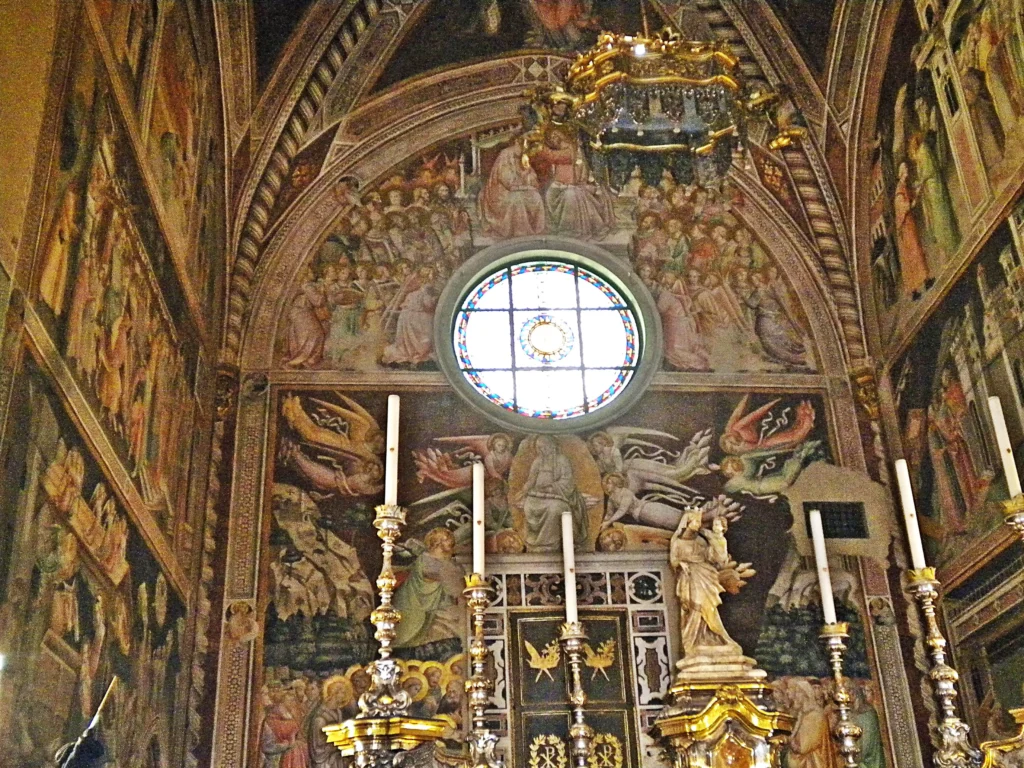
The main chapel of the Cathedral of Santo Stefano is renowned for its extraordinary fresco cycle by Fra Filippo Lippi, completed in 1465. These frescoes, regarded as the pinnacle of Lippi’s artistic achievement, depict the Stories of St. Stephen on the right wall and the Stories of St. John the Baptist on the left. The cycle is celebrated for its sophisticated composition, graceful figures wrapped in fluid drapery, and a luminous painting technique that softens contours and enhances spatial depth. Among the most notable scenes is the Funeral of St. Stephen, set within a grand early Christian basilica, where Lippi includes a striking portrayal of Pope Pius II and a subtle self-portrait at the far right. Opposite, in the Feast of Herod, Lippi masterfully captures the elegance of the Dance of Salome and the haunting moment when the head of the Baptist is delivered to the cold and composed Herodias, all set within a richly detailed architectural backdrop.
Stained Glass Window of the Cathedral of Santo Stefano
The stained glass window in the Cathedral of Santo Stefano is a remarkable work of art, designed by Fra Filippo Lippi and crafted by the skilled glassmaker Ser Lorenzo di Antonio da Pelago. It consists of nine rectangular panels, each depicting important saints such as St. Paul, St. Peter, St. Andrew, St. John the Baptist, St. Stephen, and St. Lawrence, framed within aedicules. The upper portion of the window is dominated by a pointed lunette (cymatium) that portrays the Assumption of the Virgin, where the Sacred Girdle, a relic deeply revered by the people of Prato, is delivered by the Virgin to the faithful. This imagery ties the window to the spiritual identity of the cathedral and the town. The design and iconography of the stained glass are closely aligned with the themes found in Lippi’s fresco cycle in the chapel, with the saints and scenes from the Stories of St. Stephen and St. John the Baptist depicted in the window and on the chapel walls. The creation of the window began in 1442, after the commission was transferred from Fra Angelico to Lippi. The execution of the window took several years, with scaffolding movements documented in 1456, 1461, and 1464. The completed window showcases Lippi’s characteristic style in the figures of St. Stephen and St. Lawrence, though the more slender, Gothic-inspired figures are attributed to Lorenzo di Antonio, reflecting the blending of Renaissance naturalism with Gothic aesthetics. The window’s canopies, more restrained in form, signal a shift from the exuberance of earlier Gothic works, showing Lorenzo’s evolving style, which was influenced by the broader trends in Gothic architecture. This combination of styles makes the stained glass a visually striking and theologically rich addition to the cathedral, embodying both artistic mastery and religious devotion.
Side Chapels and Notable Artworks of the Cathedral of Santo Stefano
The Cathedral of Santo Stefano in Prato boasts a series of side chapels, each serving as a testament to the rich religious and artistic heritage of the cathedral. The Vinaccesi Chapel, located on the right side of the cathedral, houses a striking 13th-century Deposition of Christ, a poignant depiction of Christ’s descent from the cross. This chapel also features 19th-century frescoes by Alessandro Franchi, painted in the “Nazarene” style, known for their meticulous attention to detail and lively color palettes that bring depth and emotion to the sacred scenes. Adjacent to this, the Chapel of the Assumption displays frescoes by Andrea di Giusto Manzini and a young Paolo Uccello, created between 1435 and 1436. These frescoes, illustrating the Stories of the Virgin and Saint Stephen, are celebrated for their vibrant colors, bold compositions, and a unique fusion of Brunelleschi’s architectural influence, with its elegantly designed spaces that highlight the purity of the figures and the grace of the narrative. Moving to the Manassei Chapel, painted in the early 15th century by a follower of Agnolo Gaddi, the frescoes depict the Stories of Saint Margaret and Saint James, with a straightforward, unembellished narrative style that contrasts with the more intricate designs in the other chapels, yet exudes warmth and simplicity. The Inghirami Chapel on the left is home to a funerary monument attributed to Benedetto da Maiano, showcasing his delicate craftsmanship, alongside a 16th-century stained glass window that adds to the chapel’s historical allure. Finally, the Chapel of the Blessed Sacrament at the left end of the transept, built in the 16th century, houses an altarpiece by Zanobi Poggini (1549) and a beautifully decorated 19th-century vaulted ceiling, making it a significant space of spiritual reverence and artistic grandeur. Each chapel, through its art, architecture, and relics, offers a distinct glimpse into the devotional and cultural life of Prato.
Chapel of the Sacred Girdle
The Chapel of the Sacred Girdle is the most sacred area of the cathedral and is considered the heart of the city. Built between 1386 and 1390, the chapel extends from the left side nave. It consists of a single space with two spans covered by a cross vault and illuminated by a circular rose window on the back wall. The Sacred Belt, a revered relic believed to have been given by the Virgin Mary to Saint Thomas during the Assumption, is housed here. The belt arrived in Prato in the 12th century and remains central to local religious identity. The chapel is adorned with a series of frescoes depicting Stories of the Virgin and the Girdle, painted between 1392 and 1395 by Agnolo Gaddi. These frescoes demonstrate a remarkable figurative unity, with a notable representation of Prato in the fresco of the Return of Michael. The chapel’s elegant 18th-century altar is decorated with a relief by Emilio Greco and crowned by a marble Madonna and Child (circa 1301), a masterpiece by Giovanni Pisano. The chapel is enclosed by a remarkable bronze gate, created by Maso di Bartolomeo, Pasquino da Montepulciano, and their collaborators, renowned for its intricate design and naturalistic details.
Musical Chapel
The Musical Chapel was officially established in 1535, though it likely continued a musical tradition that dates back to at least 1418. The chapel’s role in the cathedral was to oversee the musical life of the church, including the organ and choral music. The chapel’s historic documents, primarily composed by chapel masters, outline the tradition of organ music and the teaching of music to local youth.
Major Organ
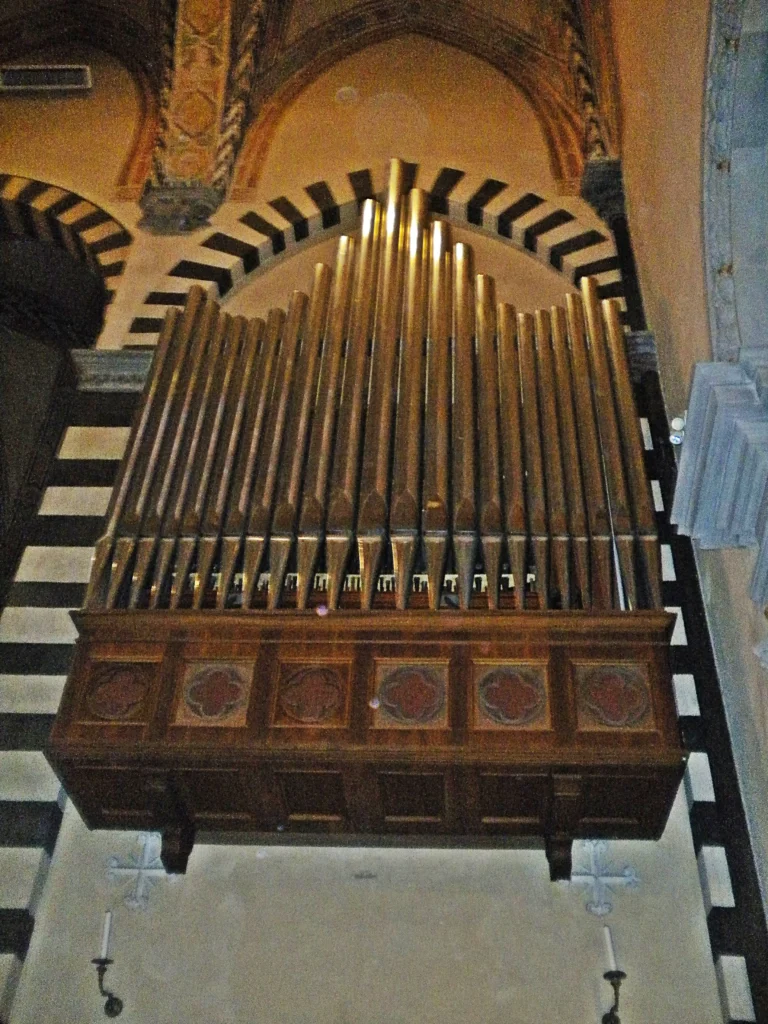
The main pipe organ of the cathedral was built in 1966 by the Paduan organ-building firm of the Ruffatti Brothers and restored in 1998. During the restoration, the Positivo was moved from the apse to the right arm of the transept and enlarged. The organ features an electronic transmission system, installed in 2000, and is equipped with an independent mobile console, three keyboards, and a concave-radial pedalboard. The instrument boasts 51 registers and 3,407 pipes, located across three distinct bodies.
Organ of the Chapel of the Sacred Cingolo
The organ in the Chapel of the Sacred Cingolo was built in 1588 by Cesare Romani and later enlarged in 1773 by Michelangelo Crudeli. This instrument is particularly unique in its placement within the chapel’s space, between the chapel and the sacristy. The console, with a single keyboard and 19-note pedalboard, controls 8 registers, including both original and later additions that enrich the sound of the organ.
Notable Works in the Cathedral
The Cathedral of Santo Stefano in Prato is home to several notable works of art that enhance its cultural and religious significance. Among the masterpieces housed within the cathedral are Filippo Lippi’s “Funeral of Saint Jerome,” which is now displayed in the Museo dell’Opera del Duomo in Prato. This poignant work reflects Lippi’s skill in conveying the emotional depth of religious scenes. Also housed in Prato’s Civic Museum is Bernardo Daddi’s “Stories of the Holy Belt,” a series of frescoes that depict the revered relic, further linking the cathedral’s spiritual heritage with the town’s history. Another significant piece is Bernardo Daddi’s “Assumption of the Virgin,” now part of the collection at the Metropolitan Museum of Art in New York, which exemplifies Daddi’s meticulous technique and devotion to capturing the divine. Together, these works, along with the cathedral’s remarkable architecture and sacred relics, contribute to the rich tapestry of Prato’s religious and cultural legacy.
Feast Day
Feast Day : 26 December
The feast day of the Cathedral Basilica of St. Stephen in Prato, Italy, is celebrated on December 26th. This date commemorates the feast of St. Stephen, the first Christian martyr, to whom the cathedral is dedicated.
Church Mass Timing
Monday : 7:30 AM, 9:30 AM and 5:30 PM.
Tuesday : 7:30 AM, 9:30 AM and 5:30 PM.
Wednesday : 7:30 AM, 9:30 AM and 5:30 PM.
Thursday : 7:30 AM, 9:30 AM and 5:30 PM.
Friday : 7:30 AM, 9:30 AM and 5:30 PM.
Saturday : 9:30 AM and 6:00 PM.
Sunday : 9:00 AM, 10:30 AM, 12:00 PM and 7:00 PM
Church Opening Time:
Monday : 7:00 am – 7:00 pm.
Tuesday : 7:00 am – 7:00 pm.
Wednesday : 7:00 am – 7:00 pm.
Thursday : 7:00 am – 7:00 pm.
Friday : 7:00 am – 7:00 pm.
Saturday : 7:00 am – 7:00 pm.
Sunday : 7:00 am – 7:00 pm.
Contact Info
Address :
Piazza del Duomo, 59100 Prato PO, Italy
Phone : +39 0574 26234
Accommodations
Connectivities
Airway
Cathedral Basilica of St. Stephen, Prato, Italy, to Amerigo Vespucci Airport, distance between 24 min (14.7 km) via A11.
Railway
Cathedral Basilica of St. Stephen, Prato, Italy, to Prato Centrale, distance between 9 min (2.2 km) via Via Pomeria.


